Solving crimes requires information, and the sooner investigators get that information, the more effective it is. In law enforcement, “forensic intelligence” describes using forensic data early in an investigation, when that information can accelerate the process of solving the case. It also means using data across cases to understand crime trends and identify links between cases, such as serial crimes. The forensic results might not be confirmed and ready for court yet, but they are a powerful tool for making connections between evidence, suspects, cases, and sites of crime. That information can guide law enforcement away from dead ends and toward meaningful leads.
The key to forensic intelligence is making data actionable as quickly as possible, so results leave the laboratory fast enough to steer law enforcement’s actions. For example, early DNA results can eliminate suspects before officers spend time investigating them, and early ballistics data can connect a linked series of crimes using the same weapon. Forensic data can also reveal patterns to help officers disrupt ongoing crimes and prevent new ones, instead of responding only to crimes that have already happened. For example, field testing samples of drugs seized by patrol officers can reveal new drugs arriving in an area before they become widespread.
Five Pillars of Forensic Intelligence
Forensic intelligence works best when it is part of a system. Links between evidence and cases do not just appear randomly. Investigators uncover those links when they have systems in place to gather and compare information from a wide range of sources — including forensic laboratory results but also police incident reports and even public health data. The systems for sharing information can be as complex as new statewide intelligence centers or as simple as weekly meetings between stakeholders (see the sidebar “Forensic Intelligence in Practice”).
To help law enforcement agencies build and refine a forensic intelligence system that fits their needs and resources, the National Institute of Justice (NIJ) has created a framework for the essential pieces of a working forensic intelligence operation. The NIJ framework has five pillars: Organization, Process, Technology, Capabilities and Resources, and Information Sharing (see Exhibit 1). Each pillar is necessary for successfully putting forensic intelligence into action.
Getting Started
To implement a forensic intelligence system, law enforcement agencies do not have to completely change their current intelligence analysis or investigation processes. They need to reexamine how they collect information for their cases and how they communicate with their partners, specifically their forensic laboratory components. For law enforcement agencies interested in implementing forensic intelligence, here are some starting points:
- Talk to your forensic laboratory about the resources they need to get results more often and more quickly. Evidence does not become intelligence until the laboratory can analyze it. Without a fast pipeline of information from forensic analysts to investigators, no forensic intelligence effort can get off the ground. But forensic laboratories have limited time, money, and equipment. They need to know what law enforcement’s priorities are so they can match those priorities as closely as possible in their own work.
- Create clear goals before launching the program. Measurable goals are the only way to track whether a program is doing what it is supposed to do. If an agency wants to increase its case clearance rates but those rates stay the same after the start of a forensic intelligence program then the agency knows that it needs to modify the program. Law enforcement should also make sure to define and track the goals of its partners, too. For example, the manager of a forensic laboratory might want to track whether sending data to law enforcement earlier can decrease the amount of testing requests for their case. The long-term success of a forensic intelligence program depends on aligning law enforcement’s goals with the goals of forensic laboratories and other partners who contribute to the program.
- Forensic intelligence is a group effort, and training should reflect that. Forensic intelligence can be a big change from the way agencies traditionally do business. In order for all the partners to start sharing information with each other more quickly, everyone will have to learn their new role in the process and start relying on new people. The best way to establish trust in this new way of operating is to train everyone in this new system together. Otherwise, if training in forensic intelligence keeps the old divisions between different agencies, new lines of communication will be too weak to succeed.
Forensic Intelligence in Practice
Adopting a forensic intelligence model does not mean discarding existing intelligence strategies. Instead, forensic intelligence approaches (represented as yellow arrows) can be built into existing investigation processes without changing the entire workflow of an individual case. Early use of forensic data and preliminary results in the investigation cycle can generate useful investigative leads and bring about faster case resolution. Processes that were linear or siloed are bridged by a holistic view of data, overcoming linkage blindness and allowing connections to be made that were not visible before. Developing a forensic intelligence program involves adding some or all of the feedback shown in yellow.



